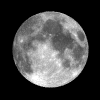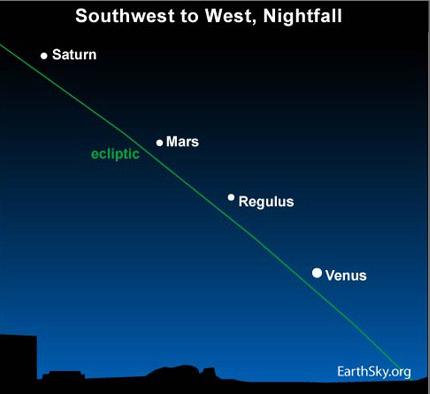Courtesy of EarthSky
A Clear Voice for Science
www.EarthSky.org [1]
 [2]
[2] [3]For people living around 40 degrees north latitude, the latest sunsets of the year happen around now. However, in the southern hemisphere, at 40 degrees south latitude, it is the year’s latest sunrises that are happening around now. That is in spite of the fact that the longest (or shortest) day was about a week ago, on the June 21 solstice.
[3]For people living around 40 degrees north latitude, the latest sunsets of the year happen around now. However, in the southern hemisphere, at 40 degrees south latitude, it is the year’s latest sunrises that are happening around now. That is in spite of the fact that the longest (or shortest) day was about a week ago, on the June 21 solstice.
To celebrate the late June sunsets, today’s sky chart shows the bright stars and planets now in the west and southwest sky after sunset. From up to down, the line-up features the planet Saturn, the planet Mars, the star Regulus [4], and the planet Venus. If you look, you will see that Venus is by far the brightest light of all.
You can see this same string of bright objects after sunset from the southern hemisphere as well. From there, this string of lights appears much more upright in the western sky.
Sunrise and sunset almanacs [5]
Notice that all the planets sit close to the ecliptic – the Earth’s orbital plane projected onto the sphere of stars. The planets orbit the sun in a nearly flat plane – the same plane as Earth’s orbit around the sun. Therefore, they cross our sky from east to west more or less along the sun’s path. That fact can help you identify planets, and it’s always lovely when – as now – several planets are near each other, strung out along the line of the ecliptic on our sky.
Regulus is not a planet of course. It is the brightest star in the constellation Leo the Lion. It just happens to be located near the ecliptic as seen from Earth.
The view of the planets is unique to this year. However, some celestial events happen predictably every year. For example, the year’s latest sunset always comes after the summer solstice, even though the exact date depends on your latitude. Farther north – at Seattle – the latest sunset happened a few days ago. Farther south at Mexico City, the latest sunset will not be for another week.
The latest sunsets come after the summer solstice because the day is more than 24 hours long at this time of the year. In June and July, the day (as measured by successive returns of the midday sun) is nearly 1/4 minute longer than 24 hours. Hence, the midday sun (solar noon) comes later today by the clock than it did on the June 21st solstice [6].
In a nutshell, it is the discrepancy between solar noon and clock noon that brings us a later sunset today than on the exact day of the summer solstice.
However, in the southern hemisphere, at 40 degrees south latitude, it is the year’s latest sunrises that are happening around now. That is in spite of the fact that the longest (or shortest) day was about a week ago, on the June 21 solstice.
To celebrate the late June sunsets, today’s sky chart shows the bright stars and planets now in the west and southwest sky after sunset. From up to down, the line-up features the planet Saturn, the planet Mars, the star Regulus [4], and the planet Venus. If you look, you will see that Venus is by far the brightest light of all.
You can see this same string of bright objects after sunset from the southern hemisphere as well. From there, this string of lights appears much more upright in the western sky.
Sunrise and sunset almanacs [5]
Notice that all the planets sit close to the ecliptic – the Earth’s orbital plane projected onto the sphere of stars. The planets orbit the sun in a nearly flat plane – the same plane as Earth’s orbit around the sun. Therefore, they cross our sky from east to west more or less along the sun’s path. That fact can help you identify planets, and it’s always lovely when – as now – several planets are near each other, strung out along the line of the ecliptic on our sky.
Regulus is not a planet of course. It is the brightest star in the constellation Leo the Lion. It just happens to be located near the ecliptic as seen from Earth.
The view of the planets is unique to this year. However, some celestial events happen predictably every year. For example, the year’s latest sunset always comes after the summer solstice, even though the exact date depends on your latitude. Farther north – at Seattle – the latest sunset happened a few days ago. Farther south at Mexico City, the latest sunset will not be for another week.
The latest sunsets come after the summer solstice because the day is more than 24 hours long at this time of the year. In June and July, the day (as measured by successive returns of the midday sun) is nearly 1/4 minute longer than 24 hours. Hence, the midday sun (solar noon) comes later today by the clock than it did on the June 21st solstice [6].
In a nutshell, it is the discrepancy between solar noon and clock noon that brings us a later sunset today than on the exact day of the summer solstice.
Astronomy Picture of the Day from NASA/JPL [7]
U.S. Naval Observator Astronomical Information cente [9]r
StarDate Online [10]
Sky and Telescope [11]
National Geographic [12]
Space Com [13]
Amazing Space [14]
The York County Astronomical Society [15]
Scope City [16]